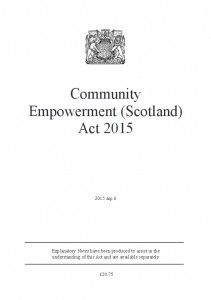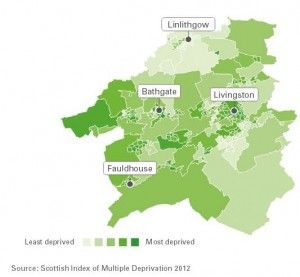New Powers for Community Planning Partnerships
Through the Community Empowerment (Scotland) Act 2015, the statutory responsibilities of Community Planning Partnerships (CPPs) have been expanded and consolidated. This latest set of changes may be particularly significant for community regeneration as it introduces a new socio-economic inequalities duty for CPPs in which they must agree to reduce:
“inequalities of outcome…unless the partnership considers that it would be inappropriate to do so”.
This briefing looks at one of the new responsibilities delegated to CPPs, namely the creation of locality plans, which relate to this new duty. As the relevant orders, regulations and guidance are currently being developed by the Scottish Government and are not due for release until spring/ summer 2016, this report is based on information obtained from Local Authority and sector reports.
To provide context for these locality plans, this article will first give a critical overview of Community and Neighbourhood Planning. This will be followed by a summary of the new provisions for locality planning, as set out in the 2015 Act.
Community & Neighbourhood Planning
Community Planning
Improving core local services are considered a key part of implementing regeneration policy. This can be achieved through Community Planning- a process created to plan and coordinate public service provision through cooperation and consultation between relevant organisations, as first mandated by the Local Government in Scotland Act 2003. It is facilitated by Community Planning Partnerships (CPPs), statutory organisations set up by Local Authorities (LAs), which comprise partners including the LA itself, the Scottish Government and public service providers.
These Partnerships should embody an atmosphere of “trust and openness” where stakeholder concerns are represented and policy decisions are accountable and evaluated regularly. In taking this approach, Community Planning aims to commit service providers to work effectively in partnership to contribute to a greater quality of service provision and therefore, the well-being of communities.
In addition, Community Planning was also formally established to ensure that people and communities are actively engaged in public service decision-making to ensure local needs and aspirations are addressed. Accordingly, alongside specific statutory bodies, the process may also involve a range of public, private and voluntary organisations and individuals, although this is subject to the discretion of LAs.

The Edinburgh Partnership, 2013.
The current agenda for CPPs, until the implementation of the 2015 Act, is set out in plans known as Single Outcome Agreements (SOAs), which include both local and national priorities. While the founding pillars of Community Planning have stayed constant, SOAs have become more focused following the recommendations of the Christie Commission report on the Future Delivery of Public Services in 2011.
This led to public service reform where national priorities for service provision were created to address ‘deep-rooted persistent social problems’. In line with these priorities, for service provision, SOAs must adopt preventative approaches to reduce demand, increase integration and partnership-working, improve performance and develop innovative approaches. In addition to addressing national priorities, SOAs are essentially evidence-based plans where, based on key local issues, outcomes are set which must be achieved through contributions from each CPP partner.
Local (or Neighbourhood) Community Planning
To stand alongside CPPs, the establishment of Local (or Neighbourhood) Community Planning was strongly recommended in non-statutory guidance to address community level issues. As the closest existing system, examining Neighbourhood Planning (NP) in practice may indicate the potential of upcoming Locality Plans (explained in following section). In initial guidance, NP was set out to support CPPs through ‘on the ground’ partnership working, to ensure more meaningful community engagement and to allow adequate assessment of community needs.
Additionally, organisational structures for NP are not prescribed, in order to allow more local flexibility. Across the 14 LAs with NP in place, this has led to a range of different approaches. Some have created Neighbourhood Plans for every locality, such as Edinburgh, while others solely focus on disadvantaged communities, such as Fife. It is also worth noting that NP structures and terminology vary widely.
To provide a practical example, NP in West Lothian is branded as ‘locality planning’. West Lothian has nine localities, corresponding to existing multi-member wards, each with an associated evidence-based profile and action plan. There is a general focus on addressing deprivation, although each locality plan is strongly tailored to local needs and resources.

Audit Scotland, 2014.
For example, the work of the Fauldhouse locality plan, focused on reducing unemployment and poverty, benefits from working with the Community Development Trust as it helps provide bespoke community facilities and social groups. This perhaps demonstrates the strength of NP as a vehicle for partnership working with communities and the voluntary sector. This contrasts with the approach of some CPPs that have been criticised by Audit Scotland for so far proving less effective at partnership-working, leadership and achieving their outcomes, unless supported by specific project funding or legislation.
Nevertheless, Audit Scotland noted that more could be done in West Lothian to link and contribute local actions to the SOA outcomes and the strategic direction of Community Planning in the area. In addition, locality plans themselves vary in their depth and evidence base, perhaps a result of their non-statutory status and therefore smaller resource allocation. Following on from NP, it may be positive for future Locality Planning to have a more prescribed structure to allow for consistency and comparability within and between CPPs.
NB: It is important to note that West Lothian is just one example and there is likely to be significant differences between CPP areas.
Community Planning Partnerships: New Locality Plan Duties
Locality Plans: Content
As mentioned above, the new duties of CPPs focus on reducing socio-economic inequalities. This new agenda will be set out through Locality Plans. Spatially, these Plans are intended for localities that ‘experience significantly poorer outcomes which result from socio-economic disadvantage’ in comparison to other localities in their LA area and to the rest of Scotland. Localities have been broadly defined legally as smaller areas within a Local Authority CPP area. Although specific guidance is still to be released, concerns have been raised over defining the boundaries of these localities, in order that they correspond with existing administrative and service provider borders as well as being small enough to take advantage of local knowledge.
In terms of content, Locality Plans will comprise strategic priority outcomes to address socio-economic inequalities at a community-level. Although statutory guidance is yet to be disseminated, preliminary guidance produced by Angus Council suggests that these outcomes should help integrate the work of local service providers and over the longer term, be used to shape wider development planning decisions. Additionally, Locality Plans will be based on a ‘sound understanding of place’, evidenced through data analysis and community engagement, as well as linking with SOA priorities. To achieve these priority outcomes, CPPs should specify improvements to be accomplished over an appropriate timescale. Over time, these Plans should be revised and reviewed, alongside the provision of annual progress reports.
In conjunction with Locality Plans, it is worth noting that CPPs will also have to produce an overarching Local Outcomes Improvement Plan for all localities, intended to be the equivalent of current Single Outcome Agreements described above.
Locality Plans: Participation
The provisions of the 2015 Act mark a strengthened stance on community participation in Community Planning, including for the preparation of Locality Plans. In general, CPPs must now assess which community bodies are best placed to represent those experiencing inequalities resulting from socio-economic disadvantage. They must also ‘make all reasonable efforts to secure the participation’ of community bodies as well as supporting those wishing to participate. This could allow communities to make use of local knowledge to identify needs and issues, enabling them to ultimately shape and benefit from improvements.

The Edinburgh Partnership, 2013.
Supplementing this, the 2015 Act also allows community organisations to submit a participation request to ask for a service to be improved or to be part of helping to improve a service. This could potentially be very positive for communities, although the extent of this involvement will presumably be defined in upcoming statutory guidance. Additionally, preparation for the Locality Plan must involve and account for representations made by community bodies and individuals, as well as the needs and circumstances of people in the area.
